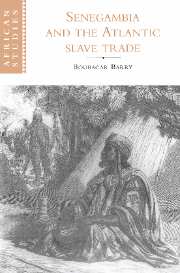Book contents
- Frontmatter
- Contents
- Preface
- Map
- I Senegambia from the fifteenth to the seventeenth century: a haven for incoming populations, a station for migrants on the move
- II Senegambia in the eighteenth century: the slave trade, ceddo regimes and Muslim revolutions
- III Senegambia in the first half of the nineteenth century: legitimate trade and sovereignty disputes
- IV Senegambia in the second half of the nineteenth century: colonial conquest and resistance movements
- 14 Colonial imperialism and European rivalries in Senegambia
- 15 Last-ditch resistance movements of legitimist rulers in northern Senegambia
- 16 The conquest of the Southern Rivers region
- 17 The balancing act of the Almamis of Timbo in their attempts to cope with centrifugal forces
- 18 Bokar Biro and the conquest of Futa Jallon
- 19 Mass resistance movements among the Joola and the Konyagi
- Conclusion
- Notes
- Bibliography
- Index
- Other books in the series
14 - Colonial imperialism and European rivalries in Senegambia
Published online by Cambridge University Press: 31 October 2009
- Frontmatter
- Contents
- Preface
- Map
- I Senegambia from the fifteenth to the seventeenth century: a haven for incoming populations, a station for migrants on the move
- II Senegambia in the eighteenth century: the slave trade, ceddo regimes and Muslim revolutions
- III Senegambia in the first half of the nineteenth century: legitimate trade and sovereignty disputes
- IV Senegambia in the second half of the nineteenth century: colonial conquest and resistance movements
- 14 Colonial imperialism and European rivalries in Senegambia
- 15 Last-ditch resistance movements of legitimist rulers in northern Senegambia
- 16 The conquest of the Southern Rivers region
- 17 The balancing act of the Almamis of Timbo in their attempts to cope with centrifugal forces
- 18 Bokar Biro and the conquest of Futa Jallon
- 19 Mass resistance movements among the Joola and the Konyagi
- Conclusion
- Notes
- Bibliography
- Index
- Other books in the series
Summary
The long transitional period from 1814 to 1876 was dominated by the triumph of legitimate trade and the recurring cycle of sovereignty disputes. It ended with the rise of colonial imperialism, which plunged France, Britain, and Portugal into a process of military conquest and the partition of Senegambia.
It was a violent process, conducted by regular armies from metropolitan Europe reinforced by local recruits. The immediate objective was territorial conquest. A useful distinction may be made between the conquest of northern Senegambia and that of the south. The former was entirely dominated by France. In southern Senegambia, however, the process of partition involved considerable competition between France, Britain, and Portugal. That circumstance left a profound imprint on the outcome. In every case, the acquisition of territory unleashed a continent-wide storm of violence in which formerly sovereign states were subjugated. The ferocity of inter-European rivalry eventually found a resolution in the 1885 Berlin Conference. That conference was convened for the purpose of defining rules for the partition process in the hope of averting a generalised conflict in metropolitan Europe.
French colonial imperialism in northern Senegambia
France was the sole power involved in the conquest of northern Senegambia. Beginning in the early 1850s, France reinforced its position through Faidherbe's conquests in the Senegal valley, starting from Saint-Louis and going along the seaboard from Kajoor to Saalum, with Gorée as the base.
- Type
- Chapter
- Information
- Senegambia and the Atlantic Slave Trade , pp. 213 - 222Publisher: Cambridge University PressPrint publication year: 1997

